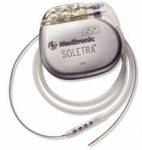Apr 27, 2006
Deep Brain Stimulation Shows Promise in Treatment of Obsessive Compulsive Disorder
Via Medgadget

According to the American Association of Neurological Surgeons, Deep Brain Stimulation (DBS) technique could be useful for obsessive compulsive disorder (OCD):
DBS has been used to treat intractable pain for several decades, and more recently, use of this technology has expanded to the FDA-approved indications for Parkinson’s disease and other movement disorders. DBS is also under investigation in the treatment of epilepsy and other debilitating neurological conditions. DBS surgery involves the placement of tiny implantable electrodes into specific parts of the brain that are functioning abnormally. These electrodes emit tiny pulses of electrical stimulation to block the abnormal activity in the brain, which causes a variety of symptoms – such as pain, tremors, movement problems; as well as obsessions, moods and anxieties associated with psychiatric disorders. The success of DBS is dependent on the surgical team’s ability to precisely pinpoint the specific brain area for stimulation. The advantage of DBS is that it is reversible, nondestructive, and can be modified by adjustment of the stimulator settings after implantation.
This study was conducted with Institutional Review Board (IRB) and Food and Drug Administration (FDA) Investigational Device Exemptions (IDE) approval. Six patients, four females and two males, with an average age of 48, were enrolled in the study from 2003 to 2005. All six patients had a history of being highly resistant to other treatments, including medication, psychotherapy, and electroconvulsive therapy (ECT). Bilateral DBS leads were implanted stereotactically in a region of the brain known as the ventral anterior internal capsule. Participants underwent standardized and detailed psychiatric, quality-of-life, and neuropsychological assessments on a regularly scheduled basis, both pre- and postsurgically.
At a minimum of six months postsurgery, four of the six patients showed a clinically significant reduction in depression severity of 50 percent or greater on the Montgomery-Asberg Depression Rating Scale. Quality-of-life measures improved as well, and patients showed progressive improvements in mood and functioning over time. One patient experienced persistent occipital pain that was alleviated with repositioning of a subcutaneous connector wire.
22:58 Posted in Neurotechnology & neuroinformatics | Permalink | Comments (0) | Tags: Positive Technology







The comments are closed.